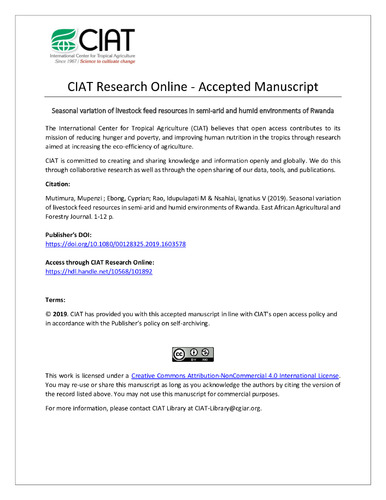Seasonal variation of livestock feed resources in semi-arid and humid environments of Rwanda
In most of sub-Saharan African countries, including Rwanda, the predominant agricultural production is from a mixed-crop-livestock farming system, because of small size land holding. The objective of this study was to assess the seasonal availability of livestock feed resources in the semi-arid and humid environments of Rwanda. Structured questionnaire was designed and administered to 102 households from each environment (totalling 204) practising mixed-crop-livestock farming system. Humid environment had more other activities than farming compared with the semi-arid. The semi-arid area had more households with dairy cows than humid environment. Household heads above 40 years and uneducated were more likely to establish fodder species for livestock. Farmers in humid environments were more likely to apply fertiliser on forages as one of the management practices than in the semi-arid areas. Household heads with above 20 years of experience in livestock rearing and uneducated household heads were also more likely to apply fertiliser on forages. Farmers in the semi-arid environments were two times more likely to establish forages in farmland than in humid environments. Various feed resources were identified in both environments. However, Napier grass was the most frequent feed resource across all season in both areas. Its availability differed (p < 0.01) between the two environments during the rainy season and during the dry season (p < 0.05) where the humid environments had the highest quantity compared with the semi-arid environments. In addition, various crop residues were also used in both areas during the rainy and dry seasons. This suggests that feed availability is based on seasonal crop harvesting, which can lead to feed shortage in a time of crop failure. Also, high use of crop residues can compromise livestock productivity, owing to low quality, suggesting the necessity to characterise the available feed resources in smallholder farms of the semi-arid and humid environments for better choice of feed.

